Features of the Rote Riesen carrot variety: description, agricultural technology, reviews
Rote Riesen carrots are popular with farmers. This is a popular late-ripening variety with good taste and high yield rates. Root crops retain their appearance and useful properties during long winter storage.
The content of the article
Description and characteristics of the variety
The Rote Riesen carrot variety is the result of the selection of the German company Maser Zamen. Carrots are late-ripening varieties, their ripening period is 135-160 days. The variety was entered in the State Register of Breeding Achievements in 1996, and it was approved for cultivation in the Central Region.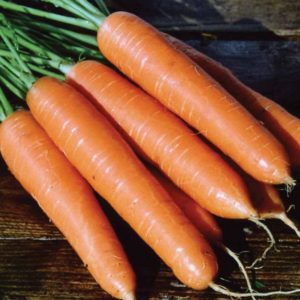
Rote Riesen carrots are intended for planting in open ground without prior germination. It resists frost, therefore it is suitable for winter sowing.
The variety is characterized by high yields, unpretentious care, stable immunity to diseases, versatility in use. Carrots of this variety are not prone to shooting and root cracking.
The yield indicators are high - 2.2-3.7 kg / m².
Subject to the recommended rules of agricultural technology, the variety is resistant to crop diseases and pests.
Bush
Rote Risen's tops reach 45-50 cm in height. The rosette is lush, spreading. Leaves are dense, medium-dissected along the edges, dark green in color; petioles are long.
Reference. The variety is characterized by dense tops, therefore, much attention is paid to thinning.
Root vegetable
Rote Riesen is distinguished by large root crops, reaching a length of 23-25 cm; base diameter varies from 4 to 6 cm. Weight is 80-140 g. Root crops have the shape of an elongated cone with a rounded tip.
The core is medium in size, thicker in large root crops. The color of the skin and flesh is deep orange or red-orange. Good taste, juicy and crispy pulp.
Growing and care rules
For growing Rote Riesen, a site with sandy loam, slightly loamy soil with neutral acidity is chosen.
Attention! Do not plant a crop on heavy, clayey soils. In such soils, root crops are deformed, grow slowly and develop poorly.
If there is such soil on the site during deep digging, sand, neutralized peat (3 kg / m²) is introduced. The soil must drain well and not retain moisture.
They begin to prepare the site in the fall, digging it over the bayonet of a shovel, breaking rough lumps, removing stones and plant debris. When digging into the soil, mineral fertilizers are applied: urea - 20 g / m², superphosphate - 15 g / m², potassium sulfate - 25 g / m². From organic matter, wood ash, humus, compost are used. Before spring planting, the soil is loosened again and organic matter is introduced.
Dates and place for landing
For culture, they choose a place lit by the sun, not darkened by trees. The site should not be in a lowland, as melt and rain water accumulates there, which leads to the formation rot.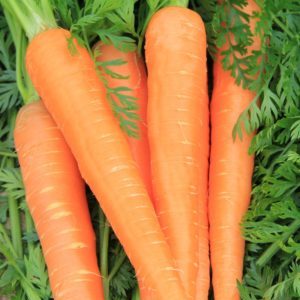
The best predecessors of the crop are potatoes, tomatoes, cucumbers, legumes, and onions.
Sowing work is carried out in the last days of April - early May. Sowing carrots begins only after the soil warms up to a depth of 10 cm to + 8 ... + 10 ° С.Since the variety is frost-resistant, some farmers practice sowing seed at + 6 ° C.
The Rote Riesen variety is also suitable for winter cultivation. Sowing is carried out at the end of October, before the temperature drops below + 5 ° C. Seeds are planted to a depth of 2-2.5 cm. The beds are mulched with peat and sawdust.
When landing in winter Rote Riesen's carrots are harvested in mid-August.
Sowing technology
For carrots, shallow beds are made at a distance of 25-30 cm from each other. Before planting, they are watered with warm, settled water and wait until the liquid is completely absorbed. To facilitate planting, the seeds are pre-glued on thin paper.
The seeds are placed to a depth of 2-2.5 cm, leaving a gap of 5-6 cm, and covered with soil, lightly pressing with your hand. Immediately after sowing, the beds are not watered, as this will provoke the formation of an earth crust and make it difficult for seeds to germinate.
Care after sowing
After sowing, the culture needs regular care, consisting of thinning the seedlings, timely removal of weeds, loosening the soil, watering and applying fertilizers.
Watering
After the emergence of seedlings, the beds are moistened every 3 days by sprinkling so that the water does not wash the seeds out of the soil. Gradually, watering is reduced to 1 time in 6-7 days. For the vegetables to grow evenly, the soil should be slightly moistened. As the root crops grow, the volume of liquid is increased when watering.
Important! Watering should not be superficial, the soil is moistened to a depth equal to the length of the carrots.
With insufficient watering, the roots wither and begin to taste bitter. Excessive watering can cause cracks in the carrots. In dry weather, Rote Riesen carrots require daily watering with a small amount of water.
Watering is stopped 20-25 days before harvesting.
Top dressing
For the growth and development of culture, top dressing is used. The first is carried out 2 weeks after germination. Nitrogen fertilizers are introduced: 15 g of urea is diluted with 10 liters of water.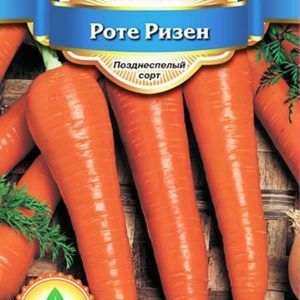
After 20 days, fertilize a second time. At this time, the formation of root crops takes place, and the culture requires potassium and phosphorus. For irrigation, a composition is prepared: 25 g of superphosphate, 20 g of potassium nitrate, 10 liters of water. Nitrogen fertilizers are no longer used, as they will lead to rapid growth of the tops.
After another 3 weeks, 3-4 g of boric acid and 2 g of potassium permanganate diluted in 10 liters of water are added to the soil. These elements are necessary for the best filling of root crops. Mineral fertilizers alternate with organic matter. The beds are watered with an infusion of wood ash: 250 g of ash are infused in 10 liters of water during the day.
Attention! Carrots cannot tolerate fresh organic fertilizers (cow dung, poultry droppings). These dressings add bitterness to root crops.
Weed control
Weeds appear on the beds faster than carrot seedlings germinate. For active growth, they take nutrients from the soil, thus inhibiting the development of carrots. Therefore, great attention is paid to weed removal.
Remove the weed from the soil carefully so as not to damage the root system of young shoots.
Thinning
For the normal development of root crops, thinning is carried out. The first time - after the formation of two true leaves. A distance of 2-3 cm is left between the shoots. The second time the shoots are thinned out after the formation of two pairs of true leaves, increasing the gap between shoots to 5-6 cm.
During thinning, the soil is loosened, removing the soil crust. Simultaneously with loosening, the rows are spud to prevent greening of the carrot tops protruding from the soil.
Prevention of diseases and pests
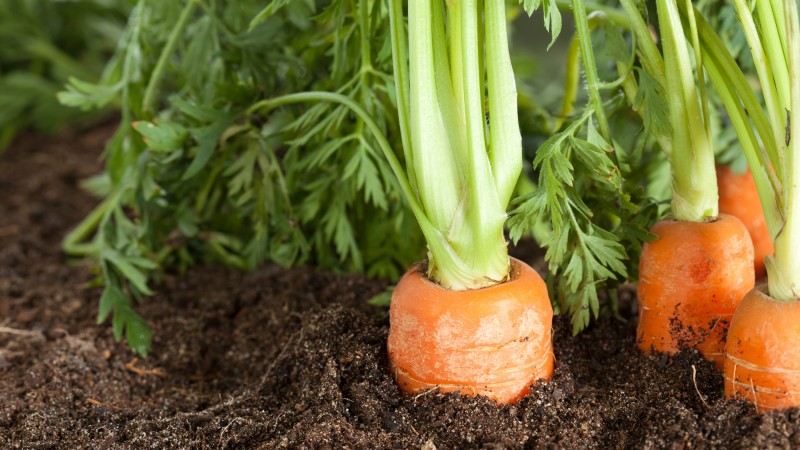
The Rote Riesen carrot variety is characterized by resistance to diseases of the culture, but if the rules of agricultural technology are violated, when the plantings are thickened and sown in soil untreated from pathogenic fungi, the culture is affected by various fungal diseases.
If the rules of crop rotation are violated or prevention has not been carried out, pest attacks are possible.
Phomoz (dry rot)
An infectious fungal disease that occurs at all stages of plant development and during storage. The disease begins with the appearance of small, depressed gray spots on the tip of the carrot.
The spots gradually become soft, acquire a brown tint. A void forms in the root crop. For the prevention of disease, potash fertilizers are applied to the soil. Before planting, the beds are treated with a 1% solution of Bordeaux liquid.
Alternaria (black rot)
Fungal infection. On young shoots, the stem begins to turn black. On adult plants, the leaves of the tops curl, turn yellow, dry out. The stems become soft, tilt towards the ground.
Patches of black rot appear on root crops. At the first signs of illness, plantings are sprayed with the drug "Rovral" (1 g is diluted in 1 liter of water).
Bacteriosis
The fungal infection begins at the edges of the lower leaves in the form of yellow spots that darken with increasing. Light gray or yellowish drops of liquid appear at the base of the petioles.
The stems are covered with brown spots, brown depressed areas and ulcers form on the root crops. An unpleasant smell comes from the plant. At the initial stage of the disease, the plants are sprayed with the HOM preparation.
Carrot fly
The insect hibernates in the soil. Its presence is indicated by a bronze tint on the leaves. Leaves curl and fall off. Root crops become unfit for human consumption.
To fight fly use drugs "Decis Profi", "Actellik". For prevention, they loosen the soil in a timely manner and remove weeds. The tops are pollinated with tobacco dust, ash.
Beetle leaf
Small insect, females of which lay eggs on carrot leaves. The larvae feed on the sap of the leaves, causing them to dry out. The tops are treated with tobacco dust, sprayed with a solution of laundry soap.
Wireworm
The larva of the click beetle. The pest feeds on root crops, eating the pulp. Damaged vegetables should not be eaten. To destroy the pest, fertilizers containing ammonia are introduced into the soil, the soil is lime before planting. Apply drugs "Bazudin", "Aktara".
Harvesting and storage
Rote Riesen carrots begin to be dug up selectively at the end of August, the main harvest is carried out in mid-September - October.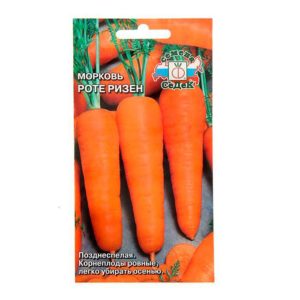
It is important to correctly determine the timing of the start of harvesting, since unripe and overripe root crops rot during storage. The degree of maturity of vegetables is determined by the beginning yellowing of the lower leaves of the tops.
For harvesting, choose dry weather. Root crops are lifted with a pitchfork and removed from the soil by pulling them by the tops. Vegetables are shaken off the remnants of the earth by tapping them. The tops are cut with a knife or twisted by hand.
After harvesting, the vegetables are sorted. Healthy root crops are transferred to a dry room to dry for 7-8 days. The damaged ones are put aside for recycling soon.
After completely drying, the carrots are placed in containers filled with sand, and cleaned up in storage... The crop is kept in a dark room at a temperature of 0 .. + 2 ° C and an air humidity of 85-95% until the end of March.
Reviews of gardeners
There are many reviews about the ease of growing and the taste of Rote Riesen carrots.
Elena, Omsk: “I plant Rote Riesen carrots for the second season. I like the ease of care. The harvest is stored for a long time in the cellar in the sand.
Oleg, Perm: “I grow this variety with winter sowing. I cover the beds with peat mixed with sawdust. In the middle of summer, I harvest delicious, juicy vegetables. Carrots make sweet fresh juice".
Natalia, Moscow region: “I have been growing this variety for several years. I like the sweet taste of crispy vegetables. It is stored for a long time in the cellar, does not fade, does not deteriorate. "
Conclusion
Late-ripening Rote Riesen carrots are in demand in many regions of the country. The variety is distinguished by long keeping quality, versatility in use, and ease of cultivation. Subject to the rules of agricultural technology, a large yield of useful root crops with a high carotene content is obtained.